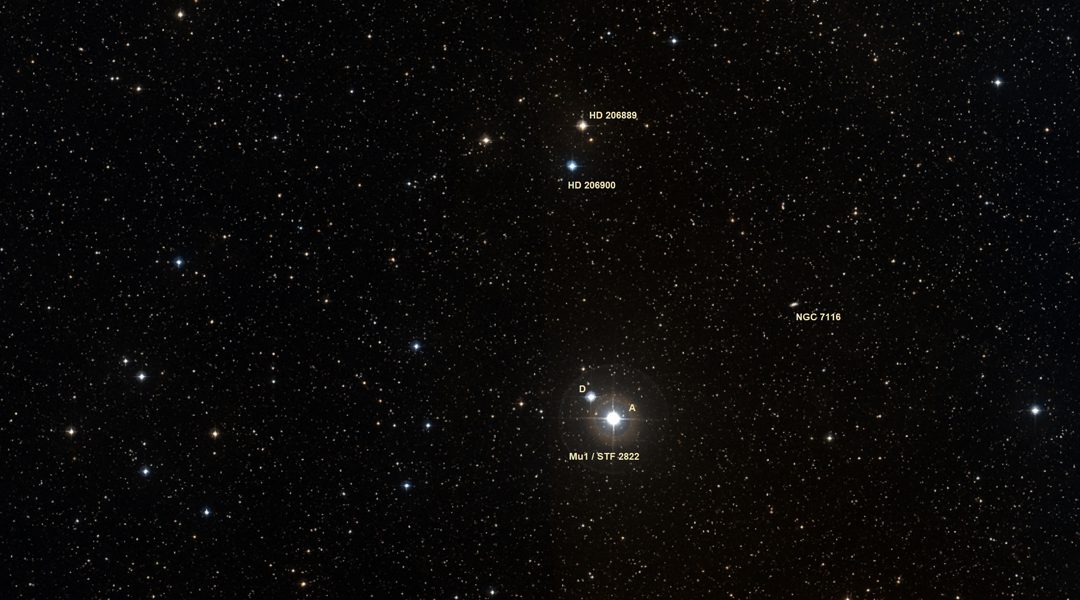The original Cygni 100 list created last summer (2022) did not include Mu1 Cygni because of the magnitude difference between the A and D components. A parameter for the first list was to limit the difference to less than 2x because a significant magnitude difference between the components makes a closer double star difficult to resolve. But an unfortunate effect of the filter parameter was to exclude wonderful binocular double stars like the widely-spaced Mu1, not to mention the brilliant and colorful trio of Omicron1.

STF 2822 / Mu1
21h44m +28*45′
AB 4.75/6.18 sep 1.6″ pa 325*
Physical double star
AD 4.75/6.94 sep 197″ pa 43*
Non-physical pair
Distance: 72.22 / 266.09 LY
Spectral Type: F6V / F0IVp
Color Index: +0.47 yellow-white / +0.36 yellow-white
Nikon 18×70 / Thursday 17 August 2023
A brilliant pale yellow primary with a white secondary, widely spaced. A pair of bright stars nearby (HD 206889 & 206900). A pleasing field with the 18×70.
The AB components of STF 2822, which is the double star discoverer code for Mu1, with a separation of only 1.6 arc-seconds, are suitable for telescopic observation but beyond the reach of most binoculars. I noticed NGC 7116 in the SIMBAD image later — a tiny, 14th magnitude galaxy that might be glimpsed as a nebulous bit of celestial lint with a 20-inch dob from a really dark site. 😉If one were so inclined…
A benefit of the Cygni 100 observing project, a consequence of the deliberate and thorough star field exploration it requires, is that it enriches one’s understanding and enjoyment of the night sky. Viewing Mu1 Cygni made me aware of the vast span crossed by the wings of Cygnus. Far wider than the primary asterism of the Northern Cross, consisting of Albireo, Sadr, Deneb, Glenah, and Al Fawaris. The traditional constellation lines in the Sky Safari image above extend the wings further to Iota2 in the west and Zeta Cygni in the east. BUT, the wings stretch even further than that, to Kappa Cygni in the west and Mu1 Cygni in the east, spanning nearly 36.5 degrees (36*23′ pa 117.8*).
I could just glimpse Mu1 naked eye from my urban yard and easily see it with hand held binoculars. Its distance from Sadr is remarkable. Cygnus is a much broader the constellation than I had realized, even after decades of astronomy. Here is a detail from Plate 11 in the Alexander Jamieson Celestial atlas (courtesy of Wikimedia Commons) with the positions of Kappa and Mu1 annotated.

How often is the Mu1 star field viewed, I wonder? With no prominent deep sky objects nearby? STF 2822 AB is included on lists of challenging subjects for double star observers, who are the most likely visitors. Admiring the vast wingspan of the celestial goose is a surely worth a binocular visit, though, with the additional bonus of a bright and wide double star. Who knows what else might be discovered in this seldom visited waypoint on Cygnus’s flight along the Milky Way. 🙂

